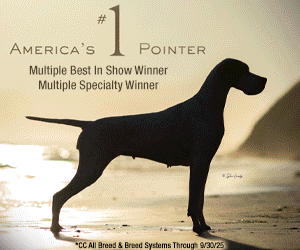Dominant & Recessive Genes
Click here to read the complete article
The Relationship Between Dominant & Recessive Genes
By William Given
A great many misconceptions seem to exist in the minds of novice and highly experienced breeders alike regarding the impact of dominant and recessive genes on phenotype. I believe this is primarily due to the purposely vague nature in which the terms are often used in many magazine articles and breed books. The general belief seems to be that any abnormality, either in conformation, health or temperament, which is known to be detrimental to an individual dog or the entirety of a breed; if it can be proved to be hereditary, is due to a recessive gene. But, must all recessively-linked characteristics be undesirable?
I have asked myself, “Cannot a recessive characteristic be desirable, or an unwanted feature be dominant?” It seems a prudent question, especially since I do not have much more than a rudimentary understanding of the fundamentals of genetics. I did get a “B” in Introduction to Genetics when I was in college but that was 35 years ago. I could be in error, but it seems reasonable to me that it would be totally unreasonable to assume that all recessive traits are faulty. When something goes wrong with a breeder’s plans and an unexpected fault emerges, must it be caused by a recessive gene? Is there no such thing as a dominant fault, and if there is, is it not likely to be more serious and a greater threat than one that is recessive?
I would never suggest all recessive characteristics are faulty, though I would be willing to go on the record as stating that the vast majority of faults appear to behave as if recessive. My generalization applies, within limits, to both structural and other inherited shortcomings and imperfections. That, however, is not the same thing as saying that recessive characteristics can never be considered as being as desirable.
The Fallacy Illustrated
For example, your breed Standard calls for a dark eye. You want to breed a litter and you, of course, want all of the puppies to have dark eyes. Your bitch has dark eyes. You have selected a top quality stud dog that is highly favored because he possesses a nice dark eye. Since both sire and dam have dark eyes, the genes required for dark eyes are present. No worries, all of your pups will have dark eyes, right? Not necessarily, one or both of the parents must be homozygous (dominant) for dark eyes.
To further illustrate my point, let me alter the scenario just a bit. The truth of the matter is that you wish your bitch had dark eyes because she actually has light eyes. Other than eye color, she truly is an excellent bitch and you feel that, bred to the right dog, she can produce a wonderful litter of pups. So, you breed her to that superior sire with the highly favored dark eyes. You must reasonably expect different results.
A light eye bred to a dark eye must naturally result in a litter of puppies where all have medium brown eyes, right? Wrong! If the sire is heterozygous, the puppies will either have dark eyes or light eyes. The puppies in your litter may all have dark eyes or all may have light eyes. More than likely though, some will have dark eyes and some light eyes, but absolutely none of them will have medium brown eyes.
Canine genetics is not a science of averaging. You cannot breed a large dog to a small bitch with the goal of getting a litter of puppies that will mature to be medium in size. Nor can you breed an aggressive dog to a timid bitch in a quest to get sound temperament. And, in no way can you breed a long, soft-coated dog to a short, hard-coated dog in hopes of getting pups with a good, medium coat.
Utilizing a make-believe breed in which several color varieties are recognized may be the simplest way to demonstrate the relationship between dominant and recessive genes. Of course, some of these colors will be dominant and some recessive to one another. In our breed, we find Black, Fawn and Brindle. Each may be regarded as equally prevalent, however, Fawn is recessive to both Black and Brindle. And although Black is dominant to Fawn, Black is itself recessive to Brindle.
The relationship between dominant and recessive genes applies equally to conformational points. The anatomical features which breeders strive for are, for the most part, dominant. There is a simple and very good reason for this. Apart from color, the genes which control the great majority of qualities asked for in a breed Standard act as dominant. Conversely, practically all faults or defects are indicative of the presence of a recessive gene.
Eliminating Genetic Faults
It should be realized that a dog which carries a gene for a dominant fault must show the fault. The presence of a dominant gene cannot remain hidden in its carrier as does the recessive.
Hereditary faults linked to dominant genes could, in theory, be expeditiously eliminated from a family line or the entire gene pool of a breed by the simple act of never breeding any individual, dog or bitch, displaying the defect. There can, I believe, never exist a truly legitimate reason for perpetuating them. The risks associated with such a venture so vastly outweigh any potential benefits. So why do breeders take the chance? The reasons are varied; ignorance of their situation, or willful denial of their situation may play a part. The more accurate reason most assuredly has to do with the amount of time, energy, but more importantly, the money they have invested in a given dog.
It would be easy for some breeders and fanciers to naturally assume that dominant linked faults are more serious and represent a greater threat than faults tied to recessive genes. To the contrary, though equally serious from the center of the show ring, dominant linked faults are much more easy to cope with and, once their nature is fully understood, never need be a matter of serious concern to a breeder.
Except in a few rare cases, a breeder is safe to regard what may be termed normal as being dominant to most pathological canine conditions. For example, dark eyes are dominant to light eyes, a strong stifle is dominant to a weak stifle, a short hock is dominant to a long hock, a level or scissors bite is dominant to being overshot or undershot, two normal descended testicles are dominant to monorchidism or cryptorchidism.
The Greater Concern
The fact is, the elimination of faults tied to recessive genes present a much more significant problem. Remember, recessive genes may be carried, and therefore transmitted, by a dog and bitch whose physical appearance provides absolutely no indication of their presence. For example, a white Boxer comes from a sire and dam that are full colored. White Boxers are not really all that rare, nor are they genetic albinos. It is important to remember that in Boxers, white is a marking pattern and not a coat color. Genetically, a white Boxer is either fawn or brindle. A deaf Dalmatian puppy may come from a sire and dam with normal hearing. It is a little discussed fact that only about 70% of Damatians possess normal, bilateral hearing. Full or partial deafness is caused by the absence or lack of mature melanocytes (pigmentation) in the inner ear. Additionally, a sire and dam who were both rated OFA excellent may produce a puppy that is diagnosed with hip dysplasia early in his show career.
It is because of the unexpected emergence of recessive linked faults. Breed columnists and others so often report the presence of undesired traits in the family line of a breed in breed journals and national club newsletters. It is irrational to assume that the individuals submitting the reports are on a vendetta and wish to tarnish the reputation of a given breeder, group of breeders or even certain lines in the breed. Might we not have common ancestors in the pedigrees of our dogs as well? I would want to know. Forewarned is forearmed.
Exiguity of Mutations
When a never before seen color or some other characteristic makes its appearance in a purebred litter, there is always the possibility that it represents a genetic mutation. A mutation is generally defined as an entirely new manifestation of a gene combination. It is, however, much more plausible that it is merely a recessive feature which has lain dormant and hidden in the family line and was suddenly and unexpectedly transformed from genotype to phenotype by the genes controlling the trait.
When recessive genes are linked to desirable traits they rarely receive any special attention or even evoke discussion among breeders. I believe this is because the qualities controlled by them must be so easy to fix that there is little need to be concerned by them. A dog that actually displays a recessive trait would have to be genetically pure for the genes which control the characteristic. That would make it impossible for the dog to possess the dominant factor, and therefore, so long as he or she is bred to similarly recessive partners, all of the resulting progeny would exhibit the trait.
This seems the perfect place for me to ask, “Is it possible that mutations are more common in domesticated canines than has been generally acknowledged?” And, “Are there both dominant and recessive mutations and do they occur about equally as often?” If the answer to any or all of our inquiries is yes, why is it that we so seldom ever hear about mutations?
I certainly have no reason to believe that observable (phenotypical) mutations in dogs, or any other mammal for that matter, to be anything but exceedingly rare. So much so, that I have never seen or even heard of one in more than thirty years in the sport of purebred dogs.
Short URL: http://caninechronicle.com/?p=95624
Comments are closed











